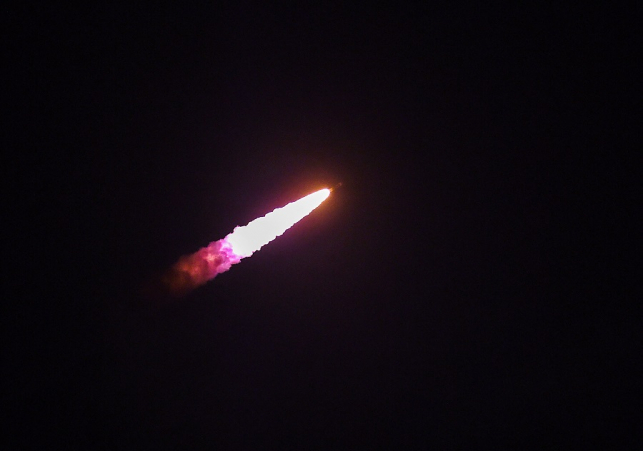

On Monday morning, ISRO's Polar Satellite Launch Vehicle PSLV-C52 launched from the Satish Dhawan Space Centre’s First Launch Pad in Sriharikota at 5:59 a.m. After a 25-hour countdown, the launch vehicle carrying the earth observation satellite EOS-04 and two co-passenger payloads – INSPIREsat-1 and INS-2TD – blasted off from the spaceport, marking India’s maiden mission launch in 2022.
The three satellites were separated and placed into their orbits 18 minutes later.
The PSLV-C52 rocket, which stands 44.4 meters tall and weighs 321 tones, rocketed up into the sky, followed by a thick orange flame. As it ascended, the rocket picked up speed and made a rolling thunder sound. The PSLV C-52 was the PSLV’s 54th flight and the 23rd mission to use the PSLV-XL variant.
According to the Indian Space Research Organisation, PSLV-C52 injected EOS-04 into a 529km altitude sun-synchronous polar orbit at 06:17am IST.
EOS-04 is a Radar Imaging Satellite that is designed to deliver high-quality images in any weather. Agriculture, forestry, and plantations, as well as soil moisture and hydrology, and flood mapping, are all potential uses for the photos.
ISRO chairman S Somanath said, “The primary satellite, EOS-04, has been put in a very precise orbit by PSLV-C52. Co-passenger satellites INS-2TD and INSPIREsat-1 have also been placed in the right orbits. This spacecraft is going to be one of the biggest assets to serve the country. We will be back again with another launch of PSLV very soon.”
Launch of ISRO PSLV-C52/EOS-04
Launch of PSLV-C52/EOS-04 https://t.co/naTQFgbm7b
Launch of PSLV-C52/EOS-04 https://t.co/naTQFgbm7b
— ISRO (@isro) February 13, 2022
PM Narendra Modi congratulated ISRO’s scientists for the successful launch of PSLV C52 mission.
He tweeted, “Congratulations to our space scientists on the successful launch of PSLV C52 mission. EOS-04 satellite will provide high resolution images under all weather conditions for agriculture, forestry and plantations, soil moisture and hydrology as well as flood mapping.”
ISRO'S PSLV
The PSLV is a four-stage/engine expendable rocket that alternates between solid (first and third stages) and liquid (second and fourth stages) fuels.
The XL edition of the rocket that flew on Monday has six booster motors with 12-ton fuel hugging the first stage to provide more thrust in the early stages of flight.
PSLV-DL (two strap-on motors), PSLV-QL (four strap-on motors), and Core Alone (no booster motors) are the other PSLV variations.
The type of rocket to utilise is determined by the satellite’s weight and the orbit into which it must be placed.
According to ISRO, India’s EOS-04, which has a 10-year life expectancy, is designed to give high-quality photos in all weather circumstances for applications including agriculture, forestry and plantations, soil moisture and hydrology, and flood mapping.
With its ability to function day, night, and in all weather situations, the satellite will play a critical role in the nation’s defence.
The EOS-04 satellite, among other things, contains advanced data handling and storage systems.
The radar imaging satellite is a follow-up to Risat-1, which was launched in 2012 and is designed to maintain SAR in the C-Band while also giving microwave data to the user community for operational purposes.
INSPIREsat-1 is a student satellite developed by the Indian Institute of Space Science and Technology (11ST) in collaboration with the University of Colorado’s Laboratory of Atmospheric and Space Physics. NTU in Singapore and NCU in Taiwan are the other contributors.
The satellite has two scientific payloads that will help researchers better understand ionosphere dynamics and the coronal heating process on the sun.
ISRO’s technology demonstration satellite (INS-2TD), which is a forerunner to the India-Bhutan Joint Satellite (INS-2B), has a thermal imaging sensor for assessing land/water surface temperature of wetlands/lakes, vegetation (crops/forests) delineation, and day/night thermal inertia.
In March, PSLV-C53 will launch three satellites – OCEANSAT-3, INS-2B, and ANAND – and in April, Micro SAT will be launched by the newly developed small rocket Small Satellite Launch Vehicle (SSLV).
The launch of four-ton communication satellite GSAT-24 is also scheduled during the first quarter of this year using Ariane 5 rocket owned by Arianespace.